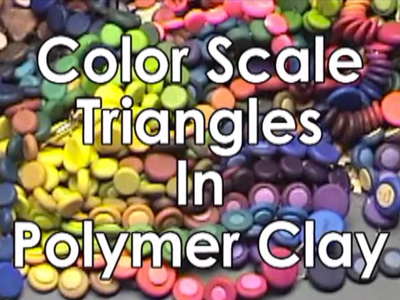Over the years I’ve tried many different ways to mix the colors in the middle of a three primary triangle. Nothing seemed to work until I came up with what I call “Base Mixing.”
Base Mixing is a two part process that starts with mixing a series of purple colors along the bottom of the triangle, running from a primary “blue/cyan” to a primary “red/magenta.” The second step is then to mix scales with each of the base colors to a primary lemon or zinc yellow.
I have found that no matter what medium I use – polymer, paint, crayons, pencils or dye – the resulting color scales always follow the same color flow.
For example, when you start with a Blue Violet base color (think of that beautiful, rich color that some people call blue and some call purple) you will always run through a gray, a gray green and an olive green on your way to yellow.
The gray will show up at different levels of the triangle depending on the tinting strength of your Yellow in comparison with the Blue Violet but some version of gray will fall along this line.
Exploring the way color flows from the various purple base colors to yellow will help you learn how to mix and shift colors without using formulas.
Try it in polymer or in any medium that you use!


March 7, 2008 at 6:14 am
What a fabulous gift to all artists! Wonderfully clear and beautifully produced. Mille gracie!
March 5, 2008 at 1:23 pm
Ciao Maggie. !!!!!!!
Wow , tomorrow I will try to do this scale triangle and then I will let you know what happened.
I love your videos, they are super.
Bye ,Claudia (from Stressa…)
February 27, 2008 at 2:22 am
Maggie I loved your work.They’re the most beautiful beads I’ve ever seen.Thank you for showing to us the way to make our owns.
October 23, 2007 at 11:06 pm
To clarify, I said “base” when I meant “primary.” What I meant to ask is whether the primaries in this case were the cobalt/fuchsia mixes, or whether the primaries were still considered the pure versions of those colors.
October 23, 2007 at 11:04 pm
Maggie, I love your videos. The music is a fun, catchy touch, too.
I do have a question about the cobalt through fuchsia mixes, though: You mix in decreasing proportions down to 1/16th cobalt at the far right, but at the opposite end, you don’t go that far with the fuchsia – only to 1/4. Why is that?
Should I be thinking of the the 3/4 cobalt and 1/4 fuchsia mix as the blue base instead of pure cobalt as such? And similarly the 1/16 cobalt and 15/16 fuchsia would be considered the red base? If I think of it that way, then really you *could* have started pure cobalt and ended with pure fuchsia, if you’d wanted them to be your base colors. Is that right? Or am I missing the point?
I hope my question is coherent. Thanks!